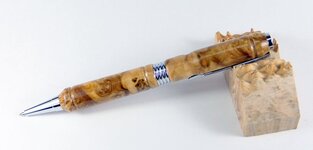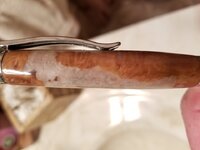I have used Mallee many times over the years and no problem with finishing.
Using paper towel to apply CA works great, but until you get accustomed to it, the paper towel will absorb about 90% and the build up of CA will be only superficial.
I also use blue paper shop towel. . And indeed, it does absorb a lot of the glue ... unless you can think of a way to stop that from happening.
I hope that reporting this is appropriate here and not a hijack of the thread, which is about ... well ... finishing.
I will toss out one of my trade secrets and see what the response is.
I fold the paper towel up into multi-layer strips, then I cut the strips apart, then I unfold each strip until it is only double-thickness and cut it into thirds. . This results in double-layer sections about 1 1/4" by 3 3/8" in size.
Remember that this is a double-layer of paper towel, not multi-layer.
In my final step, preparing for CA application, I put household "Scotch" tape (that name not being used as a trade name anymore, but a generic name now) ... it is more correctly called Invisible Tape ... totally covering one side of my double-layer piece of blue paper towel ... about 3 overlapping strips of tape.
The other side of the paper towel "Band-Aid" is used to spread the CA. . The tape prevents excessive absorption of CA through and by the paper.
And when I am applying the CA, I put this double-layer, taped piece of blue paper towel UNDERNEATH the pen blank, which is on the lathe, mounted between centers, with the lathe turning under power at extremely slow speed (like 30-60 RPM).
I drizzle the fine CA onto the top of the pen blank, and spread the CA with quite rapid back and forth motion of the paper towel piece.
There really is very little absorption of CA into the paper towel ... largely because there is very little paper compared to the way I used to do it with the multiple layers of paper ... thanks to the physical support and impermeability of the "Scotch" tape. . My fingers stay cleaner also. . No gloves.
I use both ends of the paper towel "Band-Aid" section, then cut off the glue ends and get two more applications out of it.
I have several sections ready to be used so that I can keep applying CA for about 10 minutes before getting back to the first section of towel.
Maybe someone will benefit from this. Maybe someone can improve on my method. . I know many people now use hobby store thin foam sheets. I haven't tried that but plan to do so imminently.
I apply 8-10 coats of CA and then sand smooth. . Compared to my previous method, the pre-sanding quality of the surface is much better, less sanding is required, and instead of starting the sanding process with 180 grit, I can now start at 240 or sometimes even 320. . I have been very happy with the results and my finishing process goes much quicker.


